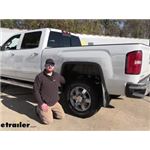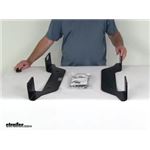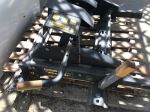Demco Premier Series Custom Mounting Brackets for 5th Wheel Above-Bed Base Rails

Will this fit?
To see if this custom-fit item will work for you please tell us what vehicle you'll use it with.
Thank you! Your comment has been submitted successfully. You should be able to view your question/comment here within a few days.
Error submitting comment. Please try again momentarily.
- All Info
- Reviews (7)
- Q & A (0)
- Videos (2)
- Photos
Demco Accessories and Parts - DM8552011
- Fifth Wheel Installation Kit
- Brackets
- Custom
- Demco
Custom brackets work with Demco universal above-bed base rails (DM6071 - sold separately) to let you install your fifth-wheel trailer hitch in the bed of your truck. No-drill frame brackets offer a simple installation. Hardware included.
Features:
- Installation brackets mount beneath your truck bed to provide attachment points for your 5th-wheel rails
- Base rails (DM6071 - sold separately) sit in your truck bed and allow installation of 5th-wheel trailer hitch
- Custom-fit brackets mount to existing holes in your vehicle's frame
- No drilling is required
- Drastically reduces installation time
- Avoids known obstacles along your truck's frame
- Sturdy, black powder coated steel resists corrosion
- Hardware included
- Made in the USA
- 5-Year limited warranty
8552011 Demco Custom Bracket Kit for High Jacker Premier Series Fifth Wheel Trailer Hitches


Videos are provided as a guide only. Refer to manufacturer installation instructions and specs for complete information.
Video Transcript for Demco Hijacker 5th Wheel Above-Bed Base Rails Mounting Brackets Installation - 2017 GMC Sierra 2500
Hey everybody, Ryan here at etrailer. Today on our 2017 GMC Sierra 2500. We're gonna be showing you how to install the Demco side plates for fifth wheel rails. But before we do that, why don't we check them out and make sure that this is something that's gonna work for you. So this is just going to have the side plates and some hardware. So you get your passenger side one and your driver's side one.
That's what we're showing off here today. And it seems like a really big reason people are looking for just the side plates is that they had another truck and already had a fifth wheel hitch set up in there. And a lot of times the hitch can carry over as well as the rails. The rails are pretty universal for the most part. I mean, there's a ton of them out there, so I can't really go over every single one of them, but generally speaking, pretty universal.
And so you want to save your hitch. You're familiar with it, you liked the way it works and everything else. So you end up getting a new truck and you don't want to have to build a whole new kit again. And so that's where picking up just the side plates are gonna become useful. You can still utilize your old rails as long as they fit with the side plates and your fifth wheel hitch itself ahead of it.
And on your new truck, you can just put the side plates, use some of that existing parts that you already had, and you'll have a hitch in there again ready to go. Now I do suggest if that's what you're doing, if you have any old hardware that's kind of beat up or anything like that, you're gonna be doing some heavy towing, probably not a bad idea into making sure some of those things are new, and that way you don't have to worry about any issues down the road. And although the rails don't come with just the side plates, if these are something you need separately as well, or these are actually what you're looking for, you can pick these up as well separately, or if you need the whole kit, if you'd just rather say I'm not gonna try to reuse anything, just give me all new stuff and call it a day, you can also pick this up as a custom fit kit as well. So, that's really nice, that custom fit stuff, you're gonna have the confidence, knowing that everything's gonna bolt up, bolt up to your truck the way you want it to. With the side brackets, these are gonna be custom fit to your truck, so they make it really easy.
On this here truck, we simply just utilize some factory weld nuts that are already in the frame, so literally the bolts just thread right in. I believe on some of the older model trucks, they don't have those weld nuts, but they utilize these openings here, so that's just gonna be, depending on what year truck you have and how you're gonna install it, but either way, you're not gonna have to drill or do anything like that, so a really convenient setup. As far as the installation goes, just the side plates are really simple like we just talked about. But chances are pretty good if you're gonna be doing that, you're probably gonna be trying to set up a whole kit. Right The whole package. So we'll go ahead and walk you through on not only how to do the side plates, but as if you we're gonna put a hitch in your truck right from the beginning. So if that information is something that you need it'll be there, if not, you can just kind of skip on past to where we're on the side plates. As far as the difficulty of the whole fifth wheels set up, if you will. As far as getting that installed, it's really not bad. Probably the hardest part to it is torquing down some of the bolts, they're just really tight and in kind of a funny spot, so I give you guys a couple of options as far as some tools that you can use that'll make that a little bit easier. So hopefully that'll help get you going. But speaking of that, why don't we go ahead and pull into the garage and put everything on together now. To begin your installation, you're gonna be here up in the bed of the truck, and first thing you want to do is clean out your bed and make it easy to work in here. If you have a drop-in bed bed liner, I suggest removing that, that'll give us the most accurate installation, and make it much easier. With that said, the first thing that you want to do is take one of your rails and we're gonna have to find the placement of it. So you're going to measure from the end of the bed, make sure you're going from the end of the bed and not the tailgate. And you're gonna take that measurement and make a mark. And then you want to refer to the instructions for that correct measurement, because there is a difference between the short bed or, I'm sorry, the six and a half foot bed and the long bed. In our case, we have the shorter bed today. But what I do is make a mark and then I just use this as a straight edge to kind of draw a line all the way cross, and I'm gonna get it roughly in position. And then you want to make sure that it is centered on the truck bed. So the way I do that is measure from our wheel well, to the edge of the rail on each side, and you want the distance to be the same. So once I find that distance, I also use a straight edge and just make a mark there. That way we have kind of a reference and we can make sure our rail is gonna be exactly where it needs to go. So since that line that we drew, the distance, they want you to line that up with the center of our rail here. and so you can kind of look down through the openings, and get it pretty close as eyeball it. But we want to go a step further and make sure it's exact. And make sure that this is perfectly square. So what I've done is take your measure, go from the end of the bed again, and just go to one edge of the rail, in our case, I just followed this one. So for example, on ours here today, the edge here is about 32 inches. And so I made sure that the other side was at 32 inches. And now we know it's exactly square. And once I found that, I just took our marker and kind of traced all the way around it. That way we have a diagram more or less on where this needs to go exactly. Now at this point, definitely need a couple of friends, you're gonna take your preassembled hitch, set the second rail upfront, roughly in position, and then we're gonna take this and actually drop it into our rails. If they move around a little bit, not a huge deal. That's why we marked that one exactly where it needs to go. So we can slide it around a little bit if need be. So once you have this in here, what you're gonna do, make sure this front rail is squared up and everything and plum. What I've done is made sure the back was where we originally had it, and then measure the distance between this edge and this edge and make sure that they're the same on each side. Not a bad idea to check the distance from your rear wells as well here. Once I found that perfect spot, again, I just drew a pattern around our front rail too just to give us a reference, make sure that we can kind of constantly keep an eye on it while we're going through this process. From there, excuse me, each one of the rails, this hole, the second one in, that's the attachment points that we're gonna be using. So I'm just gonna take a marker, put a dot in the center. I already did the other three attachment points. And then what we're gonna do is I'm gonna drill a pilot hole. Just got a small, relatively small drill bit, and before you start doing this too check underneath your truck, make sure you don't have anything that we're gonna drill into. You shouldn't, but if you have any aftermarket stuff down there, whatever, just to be on the safe side. So your best here to get it in the center. Then we'll drill a small hole on each corner. Now what we need to do is enlarge those holes that we drilled to five eighths in diameter. Problem is even if you had that large or rather tight drill bit, it's almost too big to go through this hole. And I really don't want to damage our square opening here in our rail. So since we have each hole kind of pre-drilled and marked already, what I think I'm gonna do is kind of just move our hitch out of the way a little bit. And this one looks like I was a little bit off. That's okay though. And if you move that out of the way, since we have everything marked already, we can use a step bit like this, or you can use your regular bit, whatever you're trying to do. So with that said, I'll go ahead and enlarge all of our holes. Since this one I am off just a hair, probably I'll just try to shift it over a little bit if I can. So what I've done is vacuumed up all the metal shavings, in the holes that we drilled, I shot some spray paint over them and let them dry just to get a coat of paint over that bare metal. Slide the hitch back into the rough position. Then you're gonna take these spacer blocks here. Slide that in between the corrugation and the rail. Then you're gonna take these hockey puck looking bushings, slide them in and line them up with the hole that we drilled like so, and then we're gonna take the long, I believe they're three and a half inch carriage bolts, drop them down. We're gonna to do that same thing on the three remaining corners. Now we can come over to our wheel wells and we're gonna be working on our frame rail. Wipe this down, get it clean, and we're gonna be using four attachment points to bolt up our side plates. We got two well nuts here, and two more well nuts here. Not a bad idea if you spray them down with some penetrating oil, some type of cleaner and wipe those threads clean. I'm just using a tooth brush. That way you get some of that undercoating out of there. These GM trucks, they really pack on this undercoating and any dirt would jump out of there, and what we'll to do is take our side plate. They are labeled, so you really can't mix that up. Driver's side. These slots up here, our bolts that we put in through the bed, those are gonna go through there. And coming right in on up, Hold it in place. We're gonna take a bolt, a split lock washer, and get these started hand tight. What I like to do is just get one or two of them going, that way it'll kind of hold it roughly into position. And a lot of times, what you're gonna need to do, every truck will be set up a little bit different and how you drill will vary a little bit. So you may have to kind of manipulate this plate here to get the bolts to line up perfectly. Looks like I might have to a little bit here, so what I'm gonna do is grab a tool. So I'm gonna use a tool like this, just kind of spreads out a little bit. You can see right there, one of those holes is kind of blocked a little bit. I'm just gonna take this, put it up through one of those access holes and kind of work that side plate over to hold it in possession where I need it to be. Then of course, once you have all of them started, we tighten it down and kind of draw everything together. That makes sense. So once we have these hand tight, we'll go ahead, go over to the other side and repeat the same process. Now we come back with the 15-16 socket and snug everything down. Now we need to make sure and come back with a torque wrench, tighten down all of our bolts to the amount specified in the instructions. If you don't have a torque wrench, you can grab one here at etrailer, or a lot of times if you go to your local auto parts stores, they'll have one there available to rent. So back up in the bed here, I went underneath our truck and just kind of took a look at where we're gonna need to secure these actual bolts. And upon further inspection, it seems to me we'd be better off taking these spacers that we had in here originally, and actually putting them underneath the truck on this part of the corrugation. It's kind of one of those deals, 'cause our bolt is literally going through kind of the edge of our corrugation. So it could go really either way. If you put it here, this one will crush, we put it here, that one will crush. But I think what our best option is pull these out, since we don't have anything bolted down, you can kind of just knock these out. We're gonna put these underneath. And you're also gonna have these large ones. I think we're gonna put these here, under there. And that way, if it does start to crush a little bit, this is gonna stop it and prevent that from happening. If it doesn't, not a big deal, we can always just slide these back out whenever we have everything tightened down. So I'm gonna go ahead and switch all these out and then I'll go underneath the truck. So underneath our truck, you can see it here, our frame brackets and where our bolt comes down. Take the spacer, slide this through like so. Now all these they might not go in that easy. You might have to kind of pry up on your bolt and slide the block and drop the bolt back down, or kind of pry this down a little bit. Every truck is gonna be a little bit different. But once that's in, we're gonna take a flat washer, put that on up, and a flange nut, get this going hand tight here and then repeat the same process for our three remaining corners there. So now that we have all the bolts in there and hand tight, I came back with a regular box wrench and tighten them down as much as I could. Which brings me to my next point. Now it's time to torque them down. And you don't have a ton of space up there. So you can't get kind of your classic socket on there. There's a few tools that you can use to make this a little bit easier. Now they're all gonna be 15s, 16s in size. One of them is like this, I believe this is called the dog bone if I'm not mistaken. This one worked out pretty well, it's relatively thin. The other one, you could use a crow's foot like this. And all these just go on the end of the torque wrench. Like that. So it's kind of low profile. And then there's another one. I assume this would be a crow's foot as well. It just doesn't have the extra sides, like a line wrench or something would. Unfortunately I don't have the right size in this one, but tightening a couple of bolts down already, one like this would probably work the best. So it's a lot more low-profile and a little bit easier to get in there. But with that said, we can still make do here. And now that we know what tools you can use to get this process done, let's go ahead. We're gonna grab this one and I'll show you one of them getting torqued and kind of how this works. So the way this works, it'll slide in there and go up and around the bolt. Obviously before you torque everything, you want to get them as tight as you can with the regular box wrench, try to draw everything down evenly. But once we have that done, we'll come back and make sure it's all torqued. As you could see, there's just not a ton of room up here, so it's gonna take a little bit of time, be patient with it, take a break in between if you need to. It can get a little frustrating. With everything torqued down, what I did was remove our actual fifth wheel head. And in our case, we had this bed liner. So I dropped that in, kind of eyeballed it. Kind of measured out where it's gonna hit our rails and I'm gonna just cut an opening out here. I'll lay it in there, make sure it fits and then I'll do the same thing for the rail up towards the front. So I'm just gonna use an air saw to do this. You can use a cutoff wheel kind of just whatever you have laying around. So I'll go ahead and get that done now. So got that cut out, dropped it on in and it's in there loosely, but it looks good. I'm pretty happy with it. So what I'm gonna do is measure the distance between our back rail to the front one, take some rough measurements and then I'll probably just use the piece that we cut out here kind of as a template so you can just roughly measure it, set this down, make our lines and come back and make a cut. And that'll finish up our look at and our installation of the Demco side plates for fifth wheel rails on our 2017 GMC Sierra 2500..
Customer Reviews
Demco Premier Series Custom Mounting Brackets for 5th Wheel Above-Bed Base Rails - DM8552011
Average Customer Rating: 4.9 out of 5 stars (7 Customer Reviews)
Custom brackets work with Demco universal above-bed base rails (DM6071 - sold separately) to let you install your fifth-wheel trailer hitch in the bed of your truck. No-drill frame brackets offer a simple installation. Hardware included.Fast delivery and product was as described. The only issue is they say use template but none was provided and I don’t think this was a trailer‘s fault
Great service! Order was filled and at my door step with in a few days!
Works like supposed to not real difficu lt
Product arrived in great condition and was exactly what I expected. etrailer customer service is excellent as well.

I was very pleased with the product and the promnt delivery.
See what our Experts say about this Demco Accessories and Parts
- 5th Wheel Hitch Installation Kit for a 2016 Chevy Silverado 1500 and Demco HiJacker HitchIt looks like you have a set of 4-bolt rails already with your HiJacker 5th wheel hitch so for just the under bed brackets and hardware so you can use the rails you have you can use # HT32831. The brackets are custom for your 2016 Chevy Silverado 1500. Or for a whole new kit including the rails, brackets, and hardware you can use # DM8552027-71 which is what I would do.
view full answer... - Frame Brackets to Install Base Rails for Older Demco Hijacker 5th Wheel Hitch on 2018 GMC Sierra Your Demco Hijacker model FWH24PA Ultra Slide Hitch is an older model that uses unique base rails (part # DM6014) that are specific to the hitch. In order to move those rails over from your Tundra to your new 2018 GMC 3500 you just need the Demco Custom Mounting Brackets # DM8552011. These brackets are custom-fit for your Sierra and will use existing holes in its frame so you don't have to drill into it during the installation process. Your existing Hijacker hitch is indeed compatible...
view full answer... - Fifth Wheel Rail/Bracket Kit that Fits 2005 Chevy Silverado 2500HDI have a custom fifth wheel bracket kit that fits your 2005 Chevy Silverado 2500HD with the part # C16418 which is just the brackets of the complete rail kit that fits your truck # C16418-204 but the Demco kit you mentioned fits newer Chevy trucks and Demco does not have a fit for your truck at this time.
view full answer... - Bracket Kit Recommendation for 2017 Chevy Silverado 2500HD For Older Style Demco HitchI spoke with my contact at Demco about the hitch part number you provided in order to find the correct base rails to install in your 2005 Ford F-150. The FWH 24PA is the part number for the hitch head that fit older Hijacker 5th wheel hitches. My contact at Demco confirmed that these hitches do not fit in Industry Standard Rails and require a particular rail kit, the Replacement Rails for Demco Hijacker 5th Wheel Trailer Hitch, Older Models # DM6014. These above bed rails are designed...
view full answer... - Demco Frame Brackets for a 2016 GMC Sierra 2500The correct frame brackets for your 2016 GMC Sierra 2500 is the Demco Custom Bracket Kit for High Jacker SL Series Fifth Wheel Trailer Hitches part # DM8553007 if you have the Demco Bed Rails for High Jacker SL Series Fifth Wheel Trailer Hitches part # DM6012 or the Demco Custom Bracket Kit for High Jacker Premier Series Fifth Wheel Trailer Hitches part # DM8552011 if you have the Demco Bed Rails for High Jacker Premier Series Fifth Wheel Trailer Hitches part # DM6071. The Custom Mounting...
view full answer... - Curt Fifth Wheel Bracket Kit Recommendation for 2016 Chevy Silverado 2500Since you have a set of Curt fifth wheel rails you would need to use a Curt bracket kit since we can't recommend mixing manufacturers between those two things. For a set of brackets confirmed as a fit for your 2016 Chevy Silverado 2500 you would want the part # C16411. This is a custom fit kit that does not drill into the frame of the truck. If you didn't have the rails as well you would want the part # C16411-204 which is the rail and bracket kit.
view full answer... - Rails and Brackets for Installing Hijacker FWH 24 in a 2018 Chev Silverado 3500HDYour Demco Hijacker fwh 24pa is the older style of fifth wheel hitch from Demco that uses an older unique rail design. The rails needed for it are the part # DM6071 and then for the bracket kit for your 2018 Chevy Silverado you'd want the part # DM8552011 and you'd be set. For a 7-way to install in the bed of your truck to make connecting your trailer lights easier you would want the part # 41157. Most 7-ways will be at the rear of the truck near the bumper which doesn't work will with...
view full answer... - Fifth Wheel Rail Kit Recommendation for Older Style Demco Fifth Wheel Hitch FWH 24PASince you have the older style Demco fifth wheel hitch FWH 24PA you have to use the Demco Older Style Rails part # DM6014. Then for a bracket kit you'd want the part # DM8552011 which is a custom fit bracket kit for your 2015 Chevy Silverado 2500HD.
view full answer... - Fifth Wheel SL Rail Bracket Kit Recommendation for a 2013 Chevy Silverado 1500 From looking at the picture you sent in it looks like you have a set of the SL Demco fifth wheel rails with an older Demco stationary hitch. For a bracket kit to install the rails in your truck bed you would want the part # DM8553004. With this and your rails you would basically have a # DM8553004-12.
view full answer... - Fifth Wheel Rail Kit Recommendation for 2016 Chevy Silverado 1500 Short Bed with Demco Ultra SlideWhat you sent in a picture of is an older Demco Hijacker Premier Series Ultra Slide part # DM6076P-UL-16K so for a rail kit that works with this hitch and your 2016 Chevy Silverado 1500 you'd want the part # DM8552027-71. This is a custom install kit for your truck which means it will install in less time and minimize drilling when compared to a universal rail kit.
view full answer... - Parts Needed to Install Demco FWH 24PR in 2008 Chevy Silverado 1500Your Demco Hijacker fwh 24pa is the older style of fifth wheel hitch from Demco that uses an older unique rail design. The rails needed for it are the part # DM6014 and then for the universal L-bracket kit you'd need the part # DM8552009 and you'd be set for your 2008 Chevy Silverado 1500 short bed.
view full answer...
Do you have a question about this Accessories and Part?
Info for this part was:











At etrailer.com we provide the best information available about the products we sell. We take the quality of our information seriously so that you can get the right part the first time. Let us know if anything is missing or if you have any questions.




































David
2/8/2019
It fit my truck perfectly.